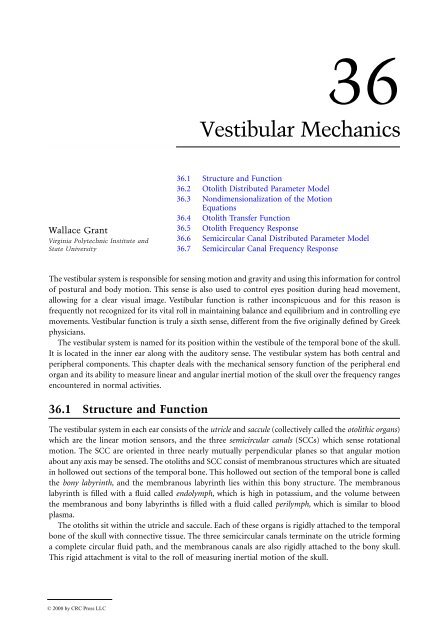chapter 36 - Vestibular Mechanics - KEMT FEI TUKE
chapter 36 - Vestibular Mechanics - KEMT FEI TUKE
chapter 36 - Vestibular Mechanics - KEMT FEI TUKE
You also want an ePaper? Increase the reach of your titles
YUMPU automatically turns print PDFs into web optimized ePapers that Google loves.
Wallace Grant<br />
Virginia Polytechnic Institute and<br />
State University<br />
© 2000 by CRC Press LLC<br />
<strong>36</strong><br />
<strong>Vestibular</strong> <strong>Mechanics</strong><br />
<strong>36</strong>.1 Structure and Function<br />
<strong>36</strong>.2 Otolith Distributed Parameter Model<br />
<strong>36</strong>.3 Nondimensionalization of the Motion<br />
Equations<br />
<strong>36</strong>.4 Otolith Transfer Function<br />
<strong>36</strong>.5 Otolith Frequency Response<br />
<strong>36</strong>.6 Semicircular Canal Distributed Parameter Model<br />
<strong>36</strong>.7 Semicircular Canal Frequency Response<br />
The vestibular system is responsible for sensing motion and gravity and using this information for control<br />
of postural and body motion. This sense is also used to control eyes position during head movement,<br />
allowing for a clear visual image. <strong>Vestibular</strong> function is rather inconspicuous and for this reason is<br />
frequently not recognized for its vital roll in maintaining balance and equilibrium and in controlling eye<br />
movements. <strong>Vestibular</strong> function is truly a sixth sense, different from the five originally defined by Greek<br />
physicians.<br />
The vestibular system is named for its position within the vestibule of the temporal bone of the skull.<br />
It is located in the inner ear along with the auditory sense. The vestibular system has both central and<br />
peripheral components. This <strong>chapter</strong> deals with the mechanical sensory function of the peripheral end<br />
organ and its ability to measure linear and angular inertial motion of the skull over the frequency ranges<br />
encountered in normal activities.<br />
<strong>36</strong>.1 Structure and Function<br />
The vestibular system in each ear consists of the utricle and saccule (collectively called the otolithic organs)<br />
which are the linear motion sensors, and the three semicircular canals (SCCs) which sense rotational<br />
motion. The SCC are oriented in three nearly mutually perpendicular planes so that angular motion<br />
about any axis may be sensed. The otoliths and SCC consist of membranous structures which are situated<br />
in hollowed out sections of the temporal bone. This hollowed out section of the temporal bone is called<br />
the bony labyrinth, and the membranous labyrinth lies within this bony structure. The membranous<br />
labyrinth is filled with a fluid called endolymph, which is high in potassium, and the volume between<br />
the membranous and bony labyrinths is filled with a fluid called perilymph, which is similar to blood<br />
plasma.<br />
The otoliths sit within the utricle and saccule. Each of these organs is rigidly attached to the temporal<br />
bone of the skull with connective tissue. The three semicircular canals terminate on the utricle forming<br />
a complete circular fluid path, and the membranous canals are also rigidly attached to the bony skull.<br />
This rigid attachment is vital to the roll of measuring inertial motion of the skull.








